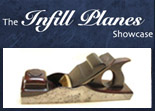Spiers No. 11 Dovetailed Bullnose Plane
 This is a dovetailed version of a Spiers bullnose plane and, therefore, is a bit more scarce than the cast versions. It’s difficult to put an exact date on this plane but it is generally believed that the dovetailed versions came a little after the cast ones – though the two coexisted for a while. It is made in the typical “Scottish style” rather than the “London Pattern” made famous by Norris and other makers. It has been suggested that the Scottish style bullnose plane is the earlier model shape and it could be argued that this makes at least some sense, as so many hand plane designs seem to come from the northern country. It’s difficult to know exactly why this would be the case, but it seems that there was some kind of “handplane renaissance” which took place in Scotland in the mid 1800’s, strongly headed by Stewart Spiers.
This is a dovetailed version of a Spiers bullnose plane and, therefore, is a bit more scarce than the cast versions. It’s difficult to put an exact date on this plane but it is generally believed that the dovetailed versions came a little after the cast ones – though the two coexisted for a while. It is made in the typical “Scottish style” rather than the “London Pattern” made famous by Norris and other makers. It has been suggested that the Scottish style bullnose plane is the earlier model shape and it could be argued that this makes at least some sense, as so many hand plane designs seem to come from the northern country. It’s difficult to know exactly why this would be the case, but it seems that there was some kind of “handplane renaissance” which took place in Scotland in the mid 1800’s, strongly headed by Stewart Spiers.
Likewise, no-one is quite sure when Spiers first produced these planes. They’re certainly not present in the Garden Street leaflet from the 1850’s but were well entrenched in the range by the late 1800’s as there are at least one or two “dated” planes from this period. In general bullnose planes were available in the Mathieson catalog of 1875 as well as other catalogs and lists but, as they’re not illustrated in these publications, it’s difficult to say just who manufactured them. Certainly it is known that James Syme of London was making these planes by 1859, along with Charles Badger (also of London) by 1865, so it could be assumed that Spiers may have been making these planes at around the same time. I should add that I’ll be putting up the drawings for a Badger bullnose in a day or two so check back for that.
The fron section on this particular plane was made from a single piece of solid steel, which makes it easier to achieve a very fine mouth opening. Typically, this Spiers bullnose plane used rosewood for the infill as well as for the wedge, though ebony was sometimes used in these and other small planes. Any dark exotic timber would look nice though.
To download a JPEG or PDF file for this hand plane (or both of them together in a ZIP file), please click one of the links below.
Download Spiers No.11 Bullnose Infill Plane (JPEG)Download Spiers No.11 Bullnose Infill Plane (PDF)Download Spiers No.11 Bullnose Infill Plane (ZIP)






